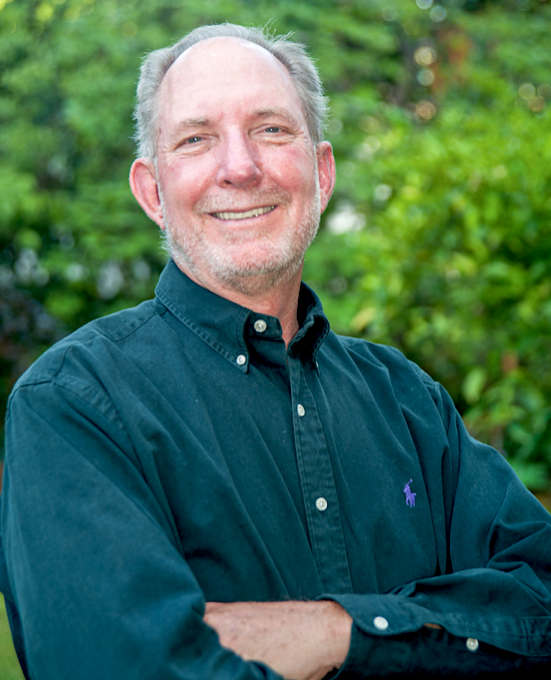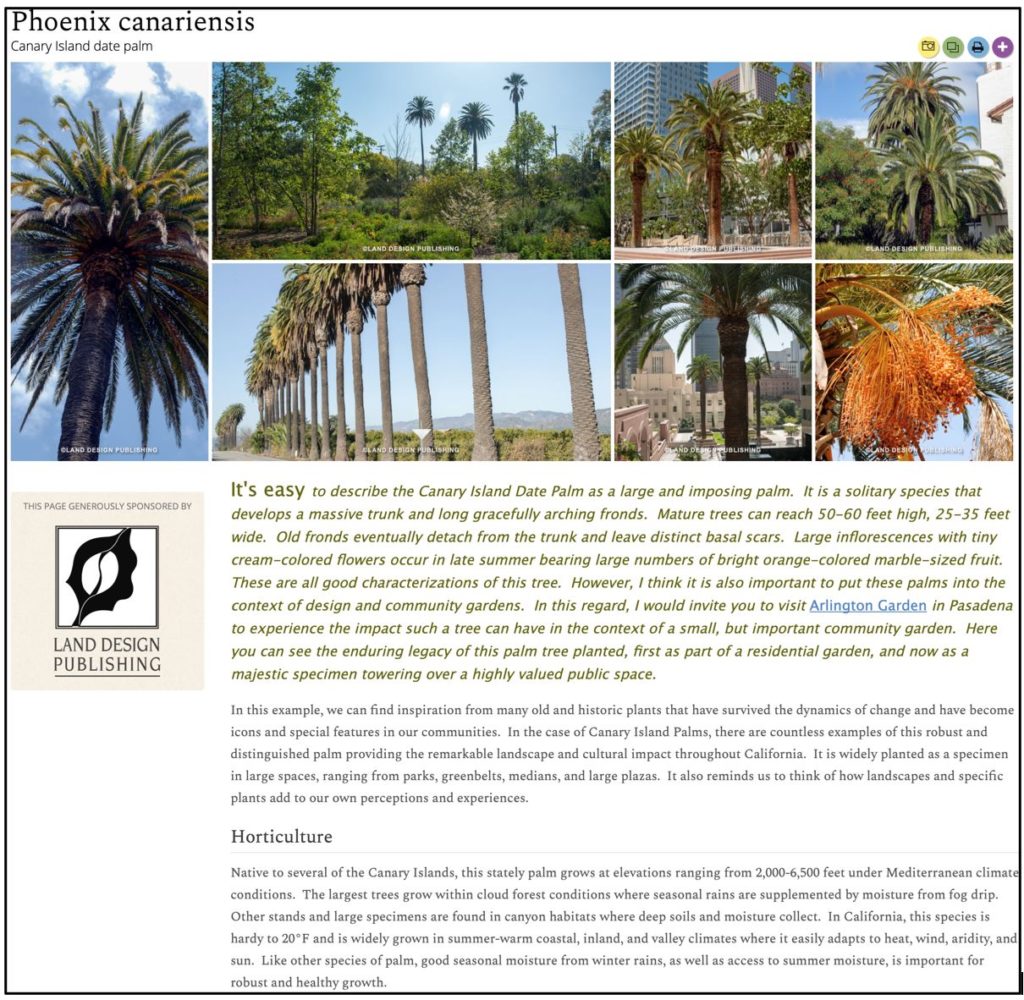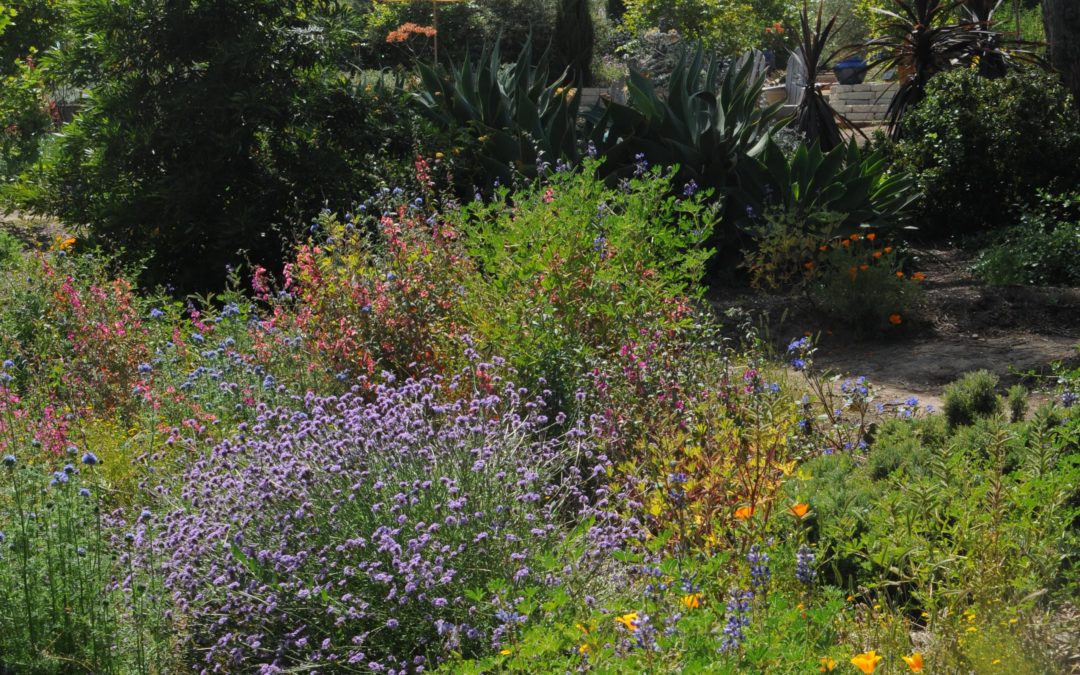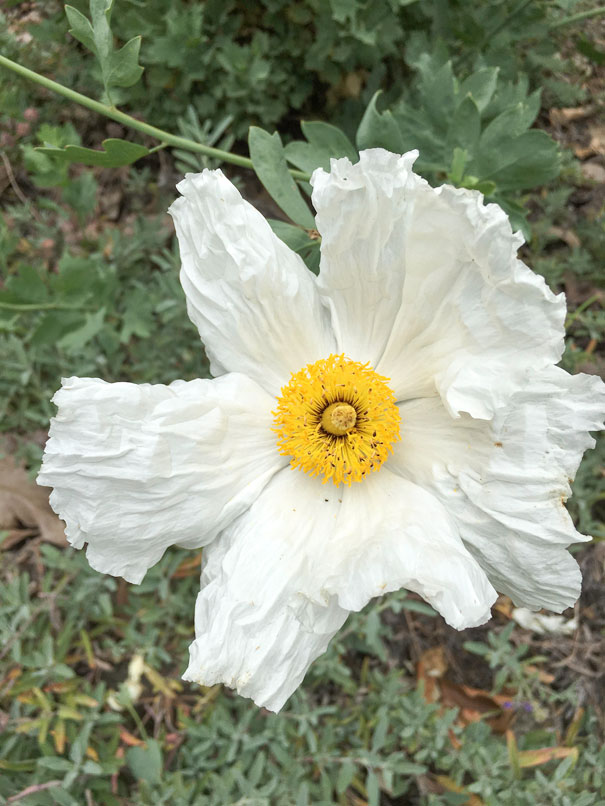Robert (Bob) Perry, FASLA is Professor Emeritus of Landscape Architecture at Cal Poly Pomona. He has been a landscape architect since 1972 and has written three award-winning books on Californian and Western landscape plants. His most recent book is Landscape Plants for California Gardens, which received an ASLA Southern California Chapter Honor Award in 2011. He is currently working on a website reference tool for gardeners and designers. The interview included Michelle Matthews, Executive Director of Arlington Garden, and it has been edited for both clarity and length.
All website and landscape images provided courtesy of Bob Perry.
AG: There are clearly aspects of the landscape, climate, and plant life in Southern California that fascinate you. Are you originally from Southern California?
 Robert Perry (RP): I am a California native. I was born less than five miles from Arlington Garden at Huntington Hospital, and I grew up in both Pasadena and Eagle Rock. I have a deep connection to much of the city of Pasadena, although it’s changed enormously in recent years, and to the San Gabriel Mountains and the Arroyo Seco. I went to college at Cal Poly Pomona and eventually moved as far away as Berkeley for graduate school. Following graduate school, I had the opportunity to return to Cal Poly Pomona where my interest in plants, and my focus on writing and teaching, really began.
Robert Perry (RP): I am a California native. I was born less than five miles from Arlington Garden at Huntington Hospital, and I grew up in both Pasadena and Eagle Rock. I have a deep connection to much of the city of Pasadena, although it’s changed enormously in recent years, and to the San Gabriel Mountains and the Arroyo Seco. I went to college at Cal Poly Pomona and eventually moved as far away as Berkeley for graduate school. Following graduate school, I had the opportunity to return to Cal Poly Pomona where my interest in plants, and my focus on writing and teaching, really began.
Without a doubt, I can speak most confidently about plant ecology and architecture in Southern California. Right now, I am working on a website that is focused on plants in the state of California as a whole. Hence, I have an endless checklist of places to visit in Central and Northern California to strengthen my understanding and descriptions.
AG: You are a landscape architect with a long history in Southern California. As well as a designer, you are also an educator, author, and academic. Could you briefly describe these different aspects of your professional career?
RP: At the end of graduate school, I took the license exam [for landscape architecture] and began teaching at Cal Poly Pomona in 1972. Cal Poly Pomona was not a research institution when I was hired, so faculty were expected to be engaged in practice. I have enjoyed teaching and practicing architecture in parallel all these years.
I would say my design work started out on a fairly limited scale. I worked in small landscape offices concurrently with teaching, nothing of great note or distinction, but as with any landscape project, I gained experience by being exposed to a wide variety of things. My design practice was the lesser of my two areas of development until I wrote my first book in 1981. That book provided me with a lot of visibility and increased my opportunities.
AG: How does your career as an educator inform your landscape architecture work?
RP: After graduating from Berkeley, I would describe myself as in great need of a broader cultural education than was necessary for becoming a technician. And teaching helped me gain this breadth of experience and become a kinder, gentler, and–I think–wiser person.
Teaching has also been great for me because I have learned far more than my students over the years! It has made me come back, again and again, to plants. And it has helped me realize how much I don’t really understand about plants, while giving me opportunities to keep learning. We couldn’t be in a better profession if we tried. We get to touch the foundations of life on this planet through the study of plants and environments.
AG: You’ve written several books on plants appropriate for dry western climates. How have they informed your work as a designer and educator?
RP: Writing books helped increase my visibility in our small profession. And I’ve been fortunate to have a professional image associated with my writing and knowledge about plants.
I hope this is a humble image: I am more aware of my journey these days and how fortunate and blessed it has been. And I am very supportive of people who are trying to find that for themselves. The measure of success is not how “far” you go. The measure of success is to engage; whether you’re making informed decisions; and whether you’re enjoying it. At the end of the day, I’d love to do it all over again with no guarantees.
AG: What is the relation between your design work and what, for lack of a better word, people call the “natural world”?
RP: I have found that abundance and diversity are always the end products in nature.
Designers should observe the natural world in order to reimagine the urban one. The two systems are not separated, and we can use the natural system as a model for our urban system. This has limits, of course, since the urban system has buildings, roads, pollution, dogs, and all sorts of other variables. We cannot just put, for example, chaparral plants in the deep shade of a building. But, as in nature, we need to strive for diversity and abundance.
We need to do this in order to provide habitat for wildlife, to sequester carbon, and to make the hot urban environment comfortable. As the population continues to grow in Southern California, gardeners and landscapes are going to lose the battle over water: it will go to the human beings.
The by-words of the future will be “rainwater harvesting” and “microclimate watershed design.” These days I advocate designing gardens that thrive only off of rainfall as in natural ecosystems. A good garden design will divert the rainwater, impound it, and distribute it to plant species adapted to this seasonality. We can do all this through surface topography. We don’t need to use rain barrels and cisterns, which are very energy intensive, and we don’t need to use more than minimal irrigation. And yes, this means that some plants will not be part of the future program here in Southern California.
AG: What is your own garden like?
RP: The plants that we have accumulated in our garden … gosh … almost every one of them is a memorial plant to a family member, a friend, a teacher, or an experience. They’re all really different: a lot of caudiciforms, succulents, and native species.
Our garden is a cacophony of memories and experiences and feelings that make me smile and feel really alive when I’m in it. I wish that I had these emotions and insights when I was thirty, because it would have enabled me to do planting design in a more artful, soulful, and chaotic way.
Arlington Garden is a great example of this kind of diverse and contradictory space. Mayita Dinos [the designer of Arlington Garden] did a really fabulous design job. Had I designed the garden, I would have done it very differently. I would have made it all very orderly, organized, structured, and hierarchical, with a few surprises. I wouldn’t have designed what Mayita did, but whenever I come to the garden I think “Damn, she did a fabulous job!”
The garden is diverse in having different areas to gather, plants from different geographies, and different ways to capture water. It’s like coming into a wonderland.
Michelle Matthews (MM): Thank you! Mayita would be really proud to hear you say that, and I am proud too.
AG: What is the website you are working on (California Plant Finder)?
RP: Currently, the website covers around 2,300 species, cultivars, and varieties of plants. It has thorough listings of California natives, particularly those we propagate and plant in our ornamental landscapes and gardens, but we also go into other plant genera and types. The priority is to list plants that fit into the framework of conservation for future California landscapes. Hence, in listing plants, we look at carbon sequestration, shade, habitat value, among other features that are to-date not commonly part of the conversation around landscape plants.
In addition, there are close to 10,000-12,000 color images which are all taken by me! As a student at Cal Poly, I got into photography, and I have carried that interest with me all these years. If you go to our image library and you search for red-flowering plants, you will be able to look through a set of images of plants with red flowers. You will also be able to look through our plant palettes, which we will assemble ourselves, or you can assemble your own plant palette from any entry in the database. So it’s intended to be a really functional tool for professionals.
 screen capture from California Plant Finder referencing the palms at Arlington Garden
screen capture from California Plant Finder referencing the palms at Arlington Garden
AG: How will California Plant Finder compare with tools like CalScape and CalFlora?
RP: We reference CalFlora all the time in California Plant Finder. When we provide background on popular native plants, for example, we indicate that there are (e.g.) 45 species of manzanita in California and 50 in the Western states. And we rely on CalFlora for that information.
CalScape, on the other hand, provides its audience with the beginnings of horticulture and design information. It’s pretty good. What I hope you will find at our site is more interpretation of those sources (as well as others) to inform you as a designer about their usefulness, their adaptations, and ways to imagine both the art and ecology of them in the landscape.
MM: You also mentioned carbon sequestration?
RP: About 50% of all plant weight is sequestered carbon. This means that the heavier your plants (or the more populated your landscape), the more carbon you sequester. And when you multiply your carbon sequestered by 3.678, you’ll get the carbon dioxide sequestered! (laughs)
I’m a bit of a science geek. (laughs) For example, did you know that every pound of biomass that our carbon-3 photosynthetic plants produce requires at least forty gallons of water … that’s the minimum! I don’t care if you’re growing roses or California sagebrush: if you compare a pound of rose petals and a pound of sagebrush foliage, it takes at least forty gallons of water to grow each of them!
It is these sorts of scientific facts that we will feature on California Plant Finder in friendly ways. And I hope that website can move the bar up like you do at Arlington Garden — if I can focus on the garden for a moment?
AG: Of course, please do! What are your thoughts about Arlington?
RP: Arlington Garden is a superstar in Southern California.
What Arlington Garden does so well is connect its visitors to the emotional dimensions of landscape and plants. CalFlora gives its audience the taxonomic, botanical, scientific description of the plant, but it doesn’t tell you much about what any of that means. In contrast, CalScape starts to interpret the meaning and usefulness of plants, but their interpretations lack human interest: the emphatic and cultural dimensions of landscape and plants.
Arlington Garden has emotion written all over it! And I think it needs to be featured that way because this dimension of landscapes is so important: without emotion, our design work is mechanical. We do it without understanding. And we often lack vision as a result.
When you look at Arlington Garden, you think: ”Oh my gosh, look at this! You can have citrus trees next to California natives next to a huge old California pepper tree!” It is a wonderful example of a multicultural garden. It is not simply diverse. It is international, multicultural, and it shows the beautiful ways that living things can coexist when the landscape emerges from a community with vision and a desire to do things better.
MM: Given the public nature of the garden, things have also just crept in over the years!
RP: And we should all be thankful for that!
Looked at from this emotional perspective, I think Arlington Garden is one of the most inspirational and important gardens in Southern California. And it needs to be celebrated and conveyed to as many people as possible, particularly to landscape architects who are still finding their own way and discovering their own ideas and reasons for doing design.
So I hope the website is able to do something like Arlington: of course, to help the audience understand the science behind–for example– rainwater capture and carbon sequestration, but also to help highlight the emotional, personal relationships we can have with plants.
MM: Bob, I think the fact that you are a photographer is really interesting. Can you come back to that for a minute and say more about your photo work?
RP: A common experience of photographers is the impulse to explore all the different ways there are of representing something and capturing the essence of it (or not).
In botanical photography, in my experience, this impulse starts by just cataloguing and classifying the exterior of the plant, but after a while it evolves to look beyond and beneath the surface. Human beings are inclined to just see the outside of things, and we don’t relate to what’s on the inside, or what it took to build the outside.
AG: What role do you think public gardens (like Arlington Garden) should have in educating the public?
RP: I think facilitating community connections is one of the most important roles of a public garden. I took one of my classes to Arlington Garden a few years back to map and inventory the plants there, and it got our students out into the real world and looking at plants in a landscape.
We have a four year curriculum at Pomona, and after the four years the students say — and I agree — that the most important and enjoyable aspect of the four years are the field trips to gardens like Arlington Garden.
AG: The issue of environmental justice has been a prominent one since the tumultuous summer, what role do you think landscape design can (or should) have in promoting justice?
RP: I use these analogies of diversity and coexistence for plants in an ecosystem, because they give us a framework in which we can all grow, live, and survive. The botanical world is not a world of political divisions, and plants coexist wonderfully well. For any plant, for it to grow into something less than “perfect” is still a beautiful expression of life, and I think this applies to human beings as well.
AG: What was the last great book/article/film that you read/watched on gardening or the natural world?
RP: The Spirit of the Valley, by Baxter Troutman.
This passage from the Foreword catches my eye:
“As a poet, I am continually frustrated by dull accumulations of biological statistics and data that seems to have no relation to the living landscape they describe. But as a scientist, I am often appalled at my own ignorance at the precise workings of my environment.”
MM: Are there any landscape architects or designers you particularly appreciate?
RP: I appreciate the work of those people who have a reason for their expressions. I went to a conference at Berkeley some years ago with James Corner, Peter Walker, and others from around the world, and it was awe-inspiring.
We are all quite different thinkers and designers, but when you pursue things with passion, it comes through in the work that you do. I saw examples of work that was very artful and needed all the necessary interventions to keep it that way, as well as work that was exploring new landscape expressions in a world that needs to be more conservation-focused. I get inspired by anyone who takes their values and finds ways to express it.
I do not extend this view about expressing one’s personal values to the national political scene. I think that that is absolutely disastrous.
AG: Finally, do you have advice for home gardeners during the pandemic?
RP: My advice is to go to a bunch of nurseries, buy a bunch of plants, and then plant them. Appreciate that they are unaware of all the strife and conflict that we humans are engaged in!




Recent Comments